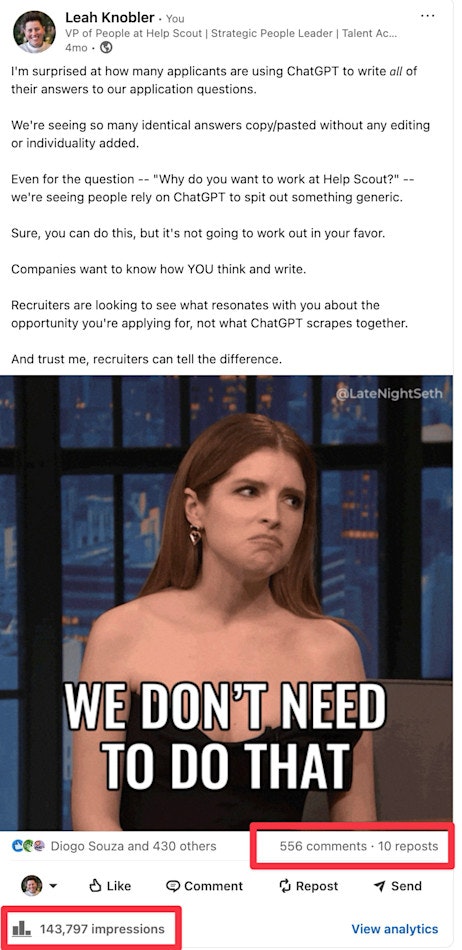These days you can’t escape use cases of artificial intelligence. It’s easy to fall into a rabbit hole of apps promising to save time, elevate content, or enhance productivity. Every day, another AI company is born promising to give you “superpowers” you didn’t have as a regular human.
(Full disclosure — I’m using Perplexity.ai as I write this to gather statistics to support my points.)
It’s clear we’re at the height of the AI boom — almost 40% of Americans, ages 18 to 64, have used generative AI, and more recently, Microsoft found that 75% of 31,000 workers surveyed use AI at work in some capacity. It’s no surprise that we also see a surge of job applicants using AI as part of the job search process. But let’s be clear — there’s a smart way to use AI to help you get ahead and a wrong way that will get you passed over.
Or at least that’s what I thought.
The great debate: To AI or not to AI
A few months back, I opened up a can of worms on LinkedIn. What started as a simple post about not relying word for word on ChatGPT when applying to a job turned into a fierce debate on the current state of the job market and the candidate experience.

The reactions surprised me and motivated me to go deeper on this topic to help job seekers navigate today’s hiring landscape more effectively. So let’s get into it!
It’s tough out there
Chances are high that either you or someone you know is looking for a new role, and those of us in tech are still experiencing spillover from the past two years of layoffs at companies that over-hired during the pandemic. While it may not feel this way, layoffs are actually historically low. However, their lingering effects leave a lot of competitive talent on the market and less demand as companies slow hiring plans.
In addition, an unforeseen consequence of the increased adoption of AI has led to greater competition in the job market. More people are using AI tools to craft better resumes, apply to more roles more quickly, and better organize and monitor their applications.
We have a lot of empathy for job seekers when conditions shift to an “employer’s market,” and we understand that trying to find your next role can easily be a full-time job in itself. It can also be demoralizing to send out tens (if not hundreds) of job applications into what feels like a black hole, often with a zero response rate. And worse, many people are finding that when they do land an interview, they often get ghosted by the company altogether.
Bad practices are happening all around, and job seekers are under an immense amount of pressure, but does that mean that job applicants should shift their approach to the process?
Job search tips that go beyond the AI prompt
I was talking about this with Erika Klics, my teammate and a lead technical recruiter here at Help Scout. When it comes to using AI in your job search, we think the answer is probably somewhere in the middle.
To show you what we mean, we’ve come up with a few tips that we think will help you have a better candidate experience and encourage you to use AI in a smarter, more thoughtful way.
Don’t hit “apply all” and hope for the best
Applying to hundreds of job openings doesn’t correlate to an increased chance of landing an interview, let alone a job. When you start applying to hundreds of openings, chances are the quality of your applications drops.
Instead, spend time homing in on job openings that are both an ideal fit for your background and skills and ones that actually interest you; then, dedicate time to nailing those applications.
TL;DR: It’s always quality over quantity.
Where to find jobs that are the right fit
While LinkedIn and job boards like Indeed are the obvious places to look, some of the best opportunities are more likely to pop up in niche Slack groups or community spaces where your experience really resonates.
Here are a few of our favorite job boards and professional communities:
It’s also a good idea to join these networking spots before you’re ready for a new role. It’s a lot easier to reach out about an interesting job req when you’ve already built a relationship with the person posting it.
Be intelligent, not artificial
We understand that people will use AI to help them in their quest to land a new role, and that’s great! But we want to stress the importance of continuing to use your own skills to add personalization to every application you submit. Don’t just rely on the robots to do everything for you! They can make mistakes, and, at the end of the day, the company wants to hire you, not the robot.
Let AI be a tool that augments your talents, not a substitute for them.
When (and how) to use AI
While you shouldn’t use AI for things like writing personal statements or answering interview questions, there are tasks where the tech can be helpful. For instance, when applying to a job, you can use AI to:
Identify the top skills in the job description.
Find information about the company (press releases, blog posts, social content, etc.) that shows what they're working on.
Make connections as to why you're a fit for that role.
Update your resume and materials to reflect those connection points.
Edit — not write — application responses and cover letters.
AI is great for cleaning up your writing or digging up facts and interesting tidbits, but it’s not so great at thinking like a human. Lean into AI’s strengths so that you can have more time to focus on the parts of the process that need your expertise.
Do your homework
A great way to stand out from the crowded applicant pool is to demonstrate you’ve looked into the company and understand the problems they’re trying to solve. While AI is a great resource for doing some of that research, if a company asks, “Why do you want to work here?,” don’t dial in your answer or copy/paste entirely from what you learned from ChatGPT.
If you’ve done your research, you should be able to put together a short, authentic response to the question.
Personalization really is that important
If a company’s application asks short answer questions, that’s a good sign that real humans will go through the answers and look for candidates who answered them thoughtfully.
So what can you do to stand out? It’s easy to fall into the trap of trying to outsmart the system, but in these situations, there is no system. We just want to hear what you have to say, and for many of these questions, there are no wrong answers. Just be yourself!
Who do you know?
We know that many roles are often filled through personal or professional connections, so you should leverage who you know. If you’ve come across a job opening at a company you’re really excited about, use LinkedIn to see if you have any connections working there. Then reach out with a respectful, short note that conveys your interest in the role and the company and how you think you’re well-suited to solve their problems.
There’s no guarantee this works, but it’s possible you’ll pique someone’s interest and they’ll mention it to the hiring team.
Is it really OK to just reach out to someone?
Yep! Even if it feels a little awkward, you're not bothering anyone when you reach out for a referral or intro. Everyone's been on the job hunt at some point in their career. People generally want to be helpful, and what goes around comes around.
Be a mensch
“Mensch” is one of my favorite words from the Yiddish language that means to be a person of integrity and honor. No matter how frustrating the job search gets, no matter how many rejections you receive, continue to be a mensch.
Responding to all rejections with professionalism could end up landing you an interview with the same company down the road.
When you interview, you’re making a connection
Not getting the job doesn’t always mean that a company doesn’t want to work with you; it might just mean that it’s not the right opportunity.
At Help Scout, it’s pretty common for us to come across a candidate that isn’t right for the role they applied for but is a perfect fit for another. If we have a good conversation with you and something else pops up, there’s a good chance we’ll remember!
A peek behind our curtain
Have you ever hit submit on a job application and wondered how the recruiter would sort through the hundreds of applications that LinkedIn says have already been submitted? While we can’t speak for every company, we thought you might enjoy a behind-the-scenes look at how we handle applications to help demystify the process.
At Help Scout, we love the applicant tracking system (ATS) Ashby, and we use it to keep all applicants organized and track their status in our hiring process. Use of an ATS is sometimes criticized by job seekers who believe that the only way to get their application in front of a hiring team is by figuring out how to “game the system.” While it’s true that we do use some automation, Ashby isn’t going to be what keeps your application out of the review pile.
I asked Erika what she thought about candidate skepticism around using an ATS:
I think it's important to be honest here. We do auto-reject applications if they don’t have the work authorization to work in their country or if they live in a country we don't have the ability to hire in. However, we never auto reject based on keywords or specific skills.
Instead, our mighty talent acquisition (TA) team goes through each and every application, reading every resume and written response, to build out a pipeline of qualified candidates who we’d like to interview. For a fully remote team like ours, outstanding written communication is essential, so we also ask all candidates to respond to a few short answer questions. We easily receive hundreds of applications per open role, so the short answer questions help us narrow down the pool.
Our TA team does not evaluate for “right” answers as much as we assess for clear, compelling responses that show that the candidate put time and thought into their application. Erika explained, “I've read, ‘I'm excited about joining Help Scout because of your strong commitment to…’ in at least 200 applications. It's a dead giveaway that an applicant used a platform like ChatGPT to write their answer.”
We’ve also seen AI-generated work during the project stage of our process, which is something that can give hiring managers pause. Engineering Manager Alejandro Rodriguez doesn’t object to candidates using generative AI in their take home projects, but he worries that heavy reliance on AI for the project can mask a candidate's problem-solving ability and decision-making rationale:
If candidates first turn to AI, we can lose valuable insight into their technical judgement, trade-offs, and creativity informed by their historical experiences; all of this shows up in the final interview. Ultimately, we're looking to evaluate the human qualities behind the code (jokes included :-)), not just an industry-standard AI output.
Bottom line: We really care about getting to know you and your process, and too much AI can sometimes get in the way of that.
Keep on keeping on
The job search can be exhausting, emotional, and — at times — deeply frustrating. We won’t sugarcoat it: Companies don’t always make the process easy, and AI has only increased competition. But while you can’t control every hiring practice, you can control your approach. Use AI as a tool, not a crutch. Focus on quality over quantity. Lean on your network. Above all, stay human in a world that’s increasingly automated.
At Help Scout, we believe hiring should be a two-way street. That’s why we ensure every applicant receives an immediate response, real feedback at later stages, and thoughtful consideration from actual humans, not just algorithms. So keep going and keep learning. Landing the right job isn’t about sending the most applications, it’s about making the right ones count.






